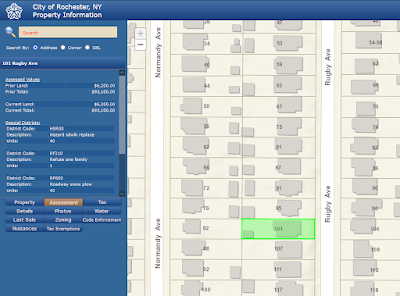An LVT for Rochester
Among mid-sized cities, Rochester may be #1 in our hearts, but it's #2 in an important metric. According to Roofstock, Rochester, NY has the second highest property tax rate among mid-sized cities (Population 150k-350k) in the United States, only behind Aurora, IL. On top of this tax, Rochesterians also pay an 8% sales tax (4% county on top of 4% state), and state income tax, the 7th highest in the nation. The tax bill for living here is painful to be sure.
Chief Justice John Marshall once wrote "The power to tax is the power to destroy", and while it often doesn't go as far as that, it isn't hard to see taxes make people go out of their way to do something. For example, the tax rate in Monroe County is 8%, while in the bordering Ontario County the tax rate is 3.5%. Eastview Mall sits in the town of Victor, just across the county border from Monroe.
Almost all of the customers for Eastview originate in Monroe county, yet because of how a line was drawn on a map some time in the early 1800s, Eastview was constructed outside of Monroe, a non-insignificant distance away from potential customers.
High taxes causes people to contort themselves to avoid paying them. Wealthy people will structure their income with stock options, or have off-shore accounts to avoid paying higher taxes. Companies will often incorporate in Delaware, which has favorable taxes for corporations. And giving some corporations special treatment in order to "boost economic development" can also be bad. Favorable tax rates to corporations can be detrimental to a community, as corporations will often search around for places to get tax breaks, pitting one locality against another. One of the most egregious examples was the Amazon search for "HQ2".
It's a generally observed fact of economics that if you increase taxes
on something you get less of it. This can be put to good use if it controls pollution or can be used to improve
public health. Hence the calls for a carbon
tax and the prevailing cigarette
taxes. But most taxes are placed on beneficial activity, like commerce, labor, or developing property. Without these taxes you would get the benefit of increased sales, and more construction, but people could spend the value added on earlier retirement, a home renovation, some nicer clothes, or the latest tech gadget.
The Perfect Tax
 |
| Henry George |
At the very end of my last post I talked about the "owners take" and how even though the value isn't created by property owners, they are able to keep the added value, created by the community or natural features of the land for themselves. The "owner's take" is called "rent" by economists, and is related to the everyday use of the word. This economic rent is responsible for much of the inequality and struggle faced by poor people in some of our wealthiest cities. In California, housing isn't affordable to anyone save tech millionaires, rent for a modest 1-BR apartment may be over $2000 a month, which forces poor people out from the bay, where they may commute in from Sacramento, over a 1-hour commute, every day. Meanwhile there are empty or underused lots which are kept off the market by land speculators, who expect the value of the land to increase with no effort on their part. An LVT would fix this.
 |
| Hard to find any property south of $1 million in Palo Alto |
The economic effects of such a tax are numerous. For one and LVT would make owning vacant land just as expensive as owning developed land, increasing the incentive to do something productive with it instead of holding it vacant. Put another way, an LVT removes the penalty for building something new. This tax has a benefit not shared by any other tax; you can tax land value all the way up to 100% and there won't be any less of it. Land can't go anywhere, it's trapped in place by the laws of physics and the makeup of the universe. Taxation impacts human behavior including what we buy, sell, build, save, and labor towards. It cannot effect what exists regardless of how people behave. For this reason an LVT has been called a "perfect tax" by some.
It is theoretically possible to fund all local government with an LVT, while letting go of payroll taxes, the income tax, sales tax, and property tax, and if there is any money left over it might be redistributed back to all citizens of that municipality. Of course such taxation policy is entirely in the hands of local government. Instead I propose implementing a partial LVT through the existing property tax, just by adding a deduction for the value of any building or improvement to the property. The tax rate would then be increased to keep the total tax levy same. This would shift the tax burden away from productive land onto vacant land or other under-built property. Everyone else would have lower taxes. The ones feeling the most "pain" from this tax change would be land speculators and slum lords, the traditional villains of a lighthearted 80s movie.
What LVT would look like in Rochester
New York State implemented a property tax cap to an increase of 2% or the rate of inflation, whichever is lower. This means that in general, if a local government gets all its funding from a property tax, the budget can only grow at most as much as inflation, and in years where inflation is higher than 2%, the budget must shrink in real terms. This really limits what can be done in terms of Georgist Taxation. The law does have a provision that the tax levy can exceed the cap if approved by 60% of the governing board. In Rochester this would constitute a 6-3 vote in the city council, just one more past a majority, in order to raise the levy above 2%.
I'm not sure exactly how Rochester assesses property values, but a whole bunch of data is accessible by the public, available here. And the Rochester city budget is also available to the public, so the numbers I'm using are mostly from those sources. This data includes not only property value, but also assessed land value, making this analysis possible in the first place. In the table below is a summary of property data and land data. These values don't exactly line up with the tax base in the budget, but they are close enough for a rough estimate. I am taking homestead properties to be synonymous with Residential property, and non-homestead to be commercial and industrial property. All the other property I am assuming is untaxed.
The way property tax works in Rochester isn't too hard to understand. According to the 2021 budget, Rochester levied a tax of $187,637,400. This amount was spread evenly over every taxable property by its assessed value, and these values are reassessed every 4 years. In order to decrease the tax burden on residential home owners, 1, 2, and 3-family residential buildings are classified as "homesteads" and subject to a lower rate. In Rochester, homestead properties constitute about 3/5 of the total property value and are responsible for about 2/5 of the total tax levy. Right now, Rochester tax rates stand at 17.16 per mille and 36.50 per mille for homesteads and non-homesteads respectively. And no, I don't know why figures are given per $1000 instead of in percent terms, I imagine it's some historical holdover.
Leaving aside whether owners of small houses should pay a lower rate in property tax at the expense of apartment buildings or commercial land. If the same tax was levied on Homestead and Non-Homestead properties, but was distributed according land value instead of total property value, the new Homestead tax rate would be $234.82 on every $1000 of land value, and the Non-Homestead Millage would be $275.57 on every $1000. It's kind of notable that the two rates converge with a LVT, so the actual results of the homestead/non-homestead difference may have inadvertantly acted in part to act as a land value tax. This may seem like a huge rate increase, but let's look at some example properties to see how things would change.
On a typical house in Rochester assessed at $93,100 the city property tax would be $1598. The assessed land value is $6,200. This home would be responsible for $1455.89 under the new system of taxation, almost a 9% decrease. Some other examples are in the table below. I'd add more, but blogger can be pretty weird about tables, and I don't
In general most places pay a modestly lower amount in taxes, but owners of vacant lots or parking lots are suddenly on the hook for more in taxes. I also want to add that the property tax isn't the only amount property owners pay to the city. There are other fees related to trash pickup, a "frontage fee" which is paid per foot of property width, goes to support roads and pipes, and also the county collects property taxes, but doesn't distinguish between homestead and non-homestead.
Lastly, NY state offers the STAR property tax
relief credit. This is pretty dumb, since home-owners are already the wealthiest class of people in the state, but also, to pay for this NY is levying sales and income taxes, so in
a way a good chunk of property taxes are actually being paid with sales
and income taxes.
Conclusion
Cities and other municipalities would do well to think in terms of maximizing their own land values. Large urban highways, places separated by large distances, uncomfortable to traverse except by car, large areas dedicated to parking. These all decrease the value of a place. We have to remember that space is a limited resource and it's zero-sum. A place that's used for parking is a place that isn't used for apartments or shops. But parking lots aren't special, so if you bulldoze a city, put in places mainly used for moving or storing automobiles, what makes that place somewhere a person would want to be?
With an LVT cities are able to make investments in their cities that will also increase their own revenue through taxation, like how a factory owner would invest in a piece of machinery. Transit lines for example have been shown to increase property values where they pass. With an LVT in place, cities don't need to raise any special taxes in order to fund the project. The value add is already a part of the new tax base. The actual levy may need to be increased, but I think the Rochester City Council would be in favor of such an increase if it were put in terms of added land value.
And no, an LVT won't solve every problem in society. I don't believe in in silver bullet solutions. I also don't believe that all a city has to do is nail down tax policy to find success. But it makes a difference when tax policy doesn't actively get in the way of the stated goals of a place.






Comments
Post a Comment